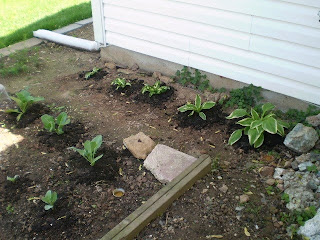Yesterday turned over my compost pile, and today spent half the morning digging up some parts of the garden still waiting to be planted with tomatoes, cucurbits and beans.
Those volunteer Lettuces we ate the other day were kind of bitter, probably because I hadn't bothered to water that patch, so I just turned them all on their heads, into the soil.
I know I've said this before, but this time I really felt like I'd made the best compost yet! It was dark and crumbly, the shovel dug in easy. Just warm on the inside, and had a sweetish smell (um, kind of like a horse stable). After shoveling dry stuff off the top and sides, to dump back into the bin, it was almost like cutting into a compost cake
I filled five buckets to add to the soil where I'm going to plant in a few weeks, and top-dressed other parts of the garden. Gave some to the Hosta and Cauliflower plants
the Rhubarb
and Garlics.
I feel like I've got my composting system down to something relatively easy, with good results now. I know a lot of people get scientific about their composting, measuring what goes in, taking temperature of the pile, adding things to boost it, etc. I don't do any of that. Here's how it works:
In the mudroom I have a five-gallon bucket or two, and a bag of last year's leaves. (All the leaves that fell in our yard are in the shed waiting to be used). All kitchen scraps (except meats or dairy products) go into the bucket, between layers of dry leaves, which keeps the smell down. I only smell it when I open the bucket, and it's not that bad. (A great side is that the kitchen trash bin rarely gets stinky). When the bucket is full, start a second one. When the second one is full, dump the first one into the pile outside, scrub it out with bleach (or mold grows on the sides, ugh) and start again.
I turn the pile once or twice a week. Every time I add weeds, expired vegetables or other yard waste, more leaves from the shed get stirred in as well. Fresh grass clippings are great for heating up the pile, but I also like to use them to mulch the tomatoes and strawberries, so the green stuff in my pile is mostly from weeds. Sick plants get trashed, not composted- also I try to avoid throwing tap roots from weeds like plantain or dandelion, and especially no weeds that have set seed, onto the pile. I learned from my mistake that dandelions which have done flowering and are folded inconspicuosly like this
will finish changing and make white poufs of seed all over the compost, even after being picked.
Anyhow, I keep the weed seeds, roots and germs out because I don't cook my pile hot enough to kill them all. The nice thing about the bucket system indoors is I don't have to go out to the pile every day to empty kitchen scraps, and I can compost straight through winter with two or three buckets going.
Subscribe to:
Post Comments (Atom)











5 comments:
We're growing garlic for the first time this year and can't wait to see how big it gets and whether it's edible. It's not as big as yours yet. We picked our first rhubarb today and it was excellent in a crumble.
I planted mine last fall, it overwinters well and then is ready to pull in late summer. The home-grown garlic has a lot stronger flavor than those I buy in the store!
My rhubarb just got planted this year; it looks delicious already but I have to wait a whole year before I can eat some! How long does the harvest last? into summer?
We put our garlic in in the autumn too but I think our hard winter slowed it up a bit. It's looking good now anyway.
Rhubarb has a long season in the UK - from April right through to July or even August.. although I think they say you shouldn't pick too late to give the plant time to recoup for the winter. Ours is only three years old so I understand that waiting thing!
Do you mulch your garlics in autumn? I always pile mine over with leaves to keep them from freezing entirely. We had two feet of snow this winter!
Mulching the garlic didn't occur to us. Thanks for the tip, we'll try that next year.
Post a Comment